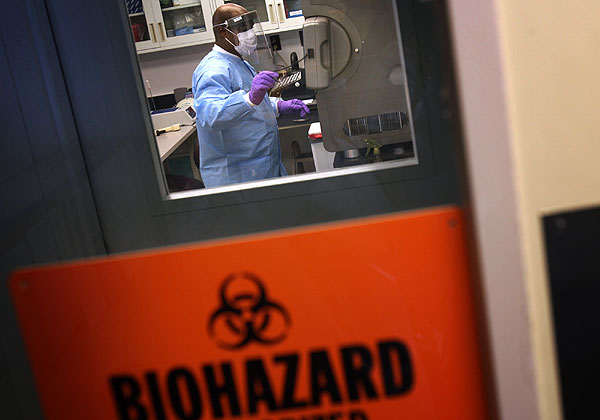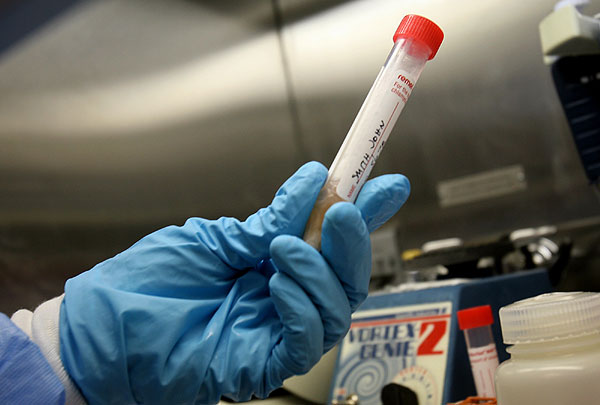NORFOLK
When it comes to swine flu, the Navy means business.
The service is putting the finishing touches on a new lab that will allow public health measures to kick in more quickly, so it can speed up detection of the disease and then react more promptly.
Currently, all Navy samples of suspected H1N1 virus are tested at the Naval Health Research Center in San Diego. Results can take up to two weeks because of travel time between coasts and the volume of samples - what Cmdr. Todd Wagner, the local unit's officer in charge, calls "the tyranny of time and distance."
With the new lab in Norfolk, the Navy expects the turnaround time to shrink to between 48 and 72 hours.
The Navy has had 470 confirmed diagnoses of the H1N1 virus since April. Last month, about 50 sailors and Marines were diagnosed with the influenza aboard the Norfolk-based amphibious assault ship Iwo Jima.
While those samples were tested in San Diego, future local outbreaks will be fielded here. The local lab is part of Navy
Environmental and Preventive Medicine Unit No. 2, based at Norfolk Naval Station.
The unit handles preventive medicine and occupational health issues and does detection work on chemical, biological and radiation agents. When its lab comes online in the next couple of weeks, it will be the Navy's only such facility on the East Coast to handle swine flu.
The lab will handle cases on ships and ashore in a massive area stretching from the Mississippi River across South America, the Atlantic Ocean, Europe, Africa, the Middle East and Antarctica. A similar unit in San Diego handles the rest of the world.
During a tour Thursday, Lt. Douglas Searles, a biochemist, walked visitors through the local unit's Biosafety Level 2+ laboratory, where the new testing equipment lives.
The machines include an auto extractor, which removes RNA samples from test swabs. Since these samples are so small and unstable, a companion replicator reverse-transcribes them into DNA and uses an enzyme to copy them thousands of times. Dye markers help pinpoint whether they contain H1N1.
In the beginning, technicians will be able to test about 50 samples a day, Wagner said. The lab will give priority to deployed and operational forces.
The technicians will cross-train others from the medical center so additional help will be ready if there's a swine flu outbreak. If necessary, the lab could also back up an overwhelmed state facility.
The lab, and the new equipment, will soon be moving to a new facility at the naval station. It will include a laboratory rated at Biosafety Level 3, meaning it can handle even more dangerous diseases.
Though the extractor and replicator currently handle H1N1, Wagner said, the lab could be adapted to identify other diseases as well, which would help the Navy get the word out as quickly as possible to a civilian population that interacts constantly with local sailors.
"Disease," Wagner said, "doesn't stop at the gate."
NORFOLK
When it comes to swine flu, the Navy means business.
The service is putting the finishing touches on a new lab that will allow public health measures to kick in more quickly, so it can speed up detection of the disease and then react more promptly.
Currently, all Navy samples of suspected H1N1 virus are tested at the Naval Health Research Center in San Diego. Results can take up to two weeks because of travel time between coasts and the volume of samples - what Cmdr. Todd Wagner, the local unit's officer in charge, calls "the tyranny of time and distance."
With the new lab in Norfolk, the Navy expects the turnaround time to shrink to between 48 and 72 hours.
The Navy has had 470 confirmed diagnoses of the H1N1 virus since April. Last month, about 50 sailors and Marines were diagnosed with the influenza aboard the Norfolk-based amphibious assault ship Iwo Jima.
While those samples were tested in San Diego, future local outbreaks will be fielded here. The local lab is part of Navy
Environmental and Preventive Medicine Unit No. 2, based at Norfolk Naval Station.
The unit handles preventive medicine and occupational health issues and does detection work on chemical, biological and radiation agents. When its lab comes online in the next couple of weeks, it will be the Navy's only such facility on the East Coast to handle swine flu.
The lab will handle cases on ships and ashore in a massive area stretching from the Mississippi River across South America, the Atlantic Ocean, Europe, Africa, the Middle East and Antarctica. A similar unit in San Diego handles the rest of the world.
During a tour Thursday, Lt. Douglas Searles, a biochemist, walked visitors through the local unit's Biosafety Level 2+ laboratory, where the new testing equipment lives.
The machines include an auto extractor, which removes RNA samples from test swabs. Since these samples are so small and unstable, a companion replicator reverse-transcribes them into DNA and uses an enzyme to copy them thousands of times. Dye markers help pinpoint whether they contain H1N1.
In the beginning, technicians will be able to test about 50 samples a day, Wagner said. The lab will give priority to deployed and operational forces.
The technicians will cross-train others from the medical center so additional help will be ready if there's a swine flu outbreak. If necessary, the lab could also back up an overwhelmed state facility.
The lab, and the new equipment, will soon be moving to a new facility at the naval station. It will include a laboratory rated at Biosafety Level 3, meaning it can handle even more dangerous diseases.
Though the extractor and replicator currently handle H1N1, Wagner said, the lab could be adapted to identify other diseases as well, which would help the Navy get the word out as quickly as possible to a civilian population that interacts constantly with local sailors.
"Disease," Wagner said, "doesn't stop at the gate."



No comments:
Post a Comment